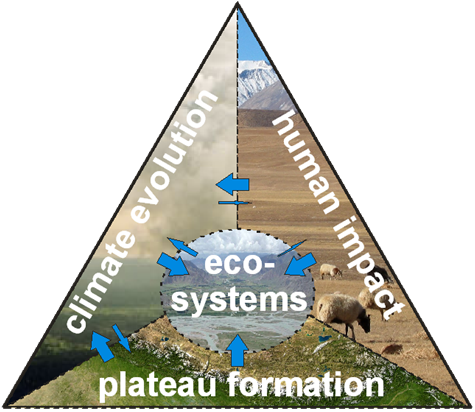Poster, EGU General Assembly 2011, Vienna: 2011-04-03 - 2011-04-08
Abstract:
The Kobresia pastures of the Tibetan Plateau represent the world’s largest alpine grassland eco-system. These pastures remained stable during the last millennia of nomadic animal husbandry. Recent sedentarisation programs, however, have changed traditional herding and promoted overgrazing, with unclear consequences for vegetation and soils, particularly for cycles of car-bon (C), nutrients and water. Vegetation-free patches of dead root-mat covered by blue-green algae and crustose lichens (crusts) are common in overgrazed Kobresia pastures, but their effect on C turnover processes is completely unknown. We tested the hypothesis that the crusts strongly affect the C cycle by examining: i) the long-term C stock: soil organic matter content; ii) medium-term C stock: dead roots; iii) recent C fluxes measured as living roots and CO2 ef-flux; and iv) fast decomposition of root exudates. Up to 7.5 times less aboveground and 1.9 less belowground living biomass were found on crust patches, reflecting a much smaller recent C input to soil as compared with the non-crust Kobresia patches. A lower C input initially changed the long-term C stock under crusts in the upper root-mat horizon. Linear regression between living roots and CO2 efflux showed that roots contributed 23% to total CO2 under non-crust areas (mean July-August 5.4 g C m-2 d-1) and 18% under crusts (5.1 g C m-2 d-1). To identify differences in the fast turnover, we added 13C labeled glucose, glycine and acetic acid, repre-senting the three main groups of root exudates. The decomposition rates of glucose (0.7 d-1), glycine (1.5 d-1) and acetic acid (1.2 d-1) did not differ under crusts and non-crusts. More 13C, however, remained in soil under crusts, reflecting less complete decomposition of exudates and less root uptake. This shows that the crust patches decrease the rates of medium-term C turn-over in response to the much lower C input. Very high 13C amounts recovered in plants from non-crust areas as well as the two-times lower uptake by roots under crusts indicate that very dense roots are efficient competitors with microorganisms for soluble organics. In conclusion, the altered C cycle in the overgrazing-induced crustose lichens and blue-green algae crusts is connected with strongly decreased C input and reduced medium-term C turnover. This may decrease the long-term C stock.

